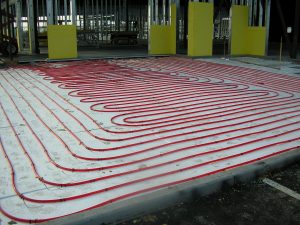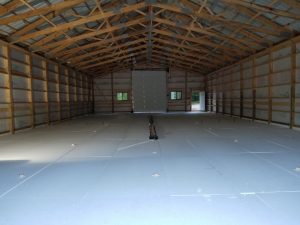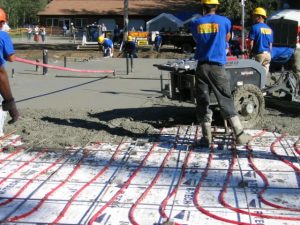Below-Grade Insulation in Radiant Heated Floors
Winter is nearly upon us. With temperatures rapidly cooling, many are turning to their home, garage and shop heating systems to ward off the chill. Yet, conventional methods used to maintain these cozy interior climates can result in sky-high utility bills.

Enter in radiant heated flooring. First implemented by the ancient Romans, this heating solution was revitalized by renowned architect Frank Lloyd Wright in the 20th century. According to This Old House, “In a radiant setup, the warmth is supplied by hot-water tubes or electric wires buried underneath the floor. As the invisible waves of thermal radiation rise from below, they warm up any objects they strike, which radiate that captured heat in turn.”
In home, workshop and basement below-grade applications, a properly insulated radiant flooring approach can be more thermally efficient than traditional radiator or ventilation systems. This increased thermal efficiency can significantly save homeowners’ and professionals’ budgets. Let’s take a look:

Basement, garage & workshop radiant flooring
We’re all familiar with the saying “heat rises,” and so it follows that ground-level spaces can be difficult and expensive to adequately heat. More often than not, areas such as basements, garages and detached workshops are built atop concrete, a material that further adds to heating challenges with its poor insulating properties.
While concrete has its drawbacks as an insulator, it is an ideal foundation for radiant heating systems. To implement this technology, professionals or DIY enthusiasts can embed hot-water tubes within a concrete slab or fasten electric heating elements to the top of a subfloor. The result is a more natural transfer of heat from the floor on up, unlike more inefficient methods that blow heated air round and round. In fact, “a radiant system can operate 25 percent more efficiently than a forced-air system,” according to home advice website bobvila.com.
The right below-grade insulation

To further increase the energy-saving potential of radiant heated floors, consider insulating below-grade. While the heat from the water tube or electric cable does radiate upwards with radiant flooring, the heat also wastefully radiates to the left, right and below the warming element. This, in turn, causes the concrete slab to become part of the overall thermal mass or part of the material that absorbs and stores heat. The higher the thermal mass, the more time it takes to fully heat the floor.
By installing Insulfoam below-grade insulation products underneath the tube or cable, however, insulation more effectively directs radiant heat upward through the floor, losing less energy. Adding expanded polystyrene (EPS) insulation also helps achieve a thermal barrier between the heat source and concrete slab, reducing the floor’s heat-up time.
What’s more, EPS insulation offers impressive R-values, along with moisture, mold and mildew resistance, boosting below-grade performance and lifespan. The EPS boards also help create a flat, even surface, which allows for easier installation of the heating elements and finished floor.
So, when looking to renovate or build a basement, garage or workshop, consider radiant heated floors combined with EPS insulation for the biggest bang for your buck. Talk with your local Insulfoam Rep to get fitted with the right below-grade insulation today.

